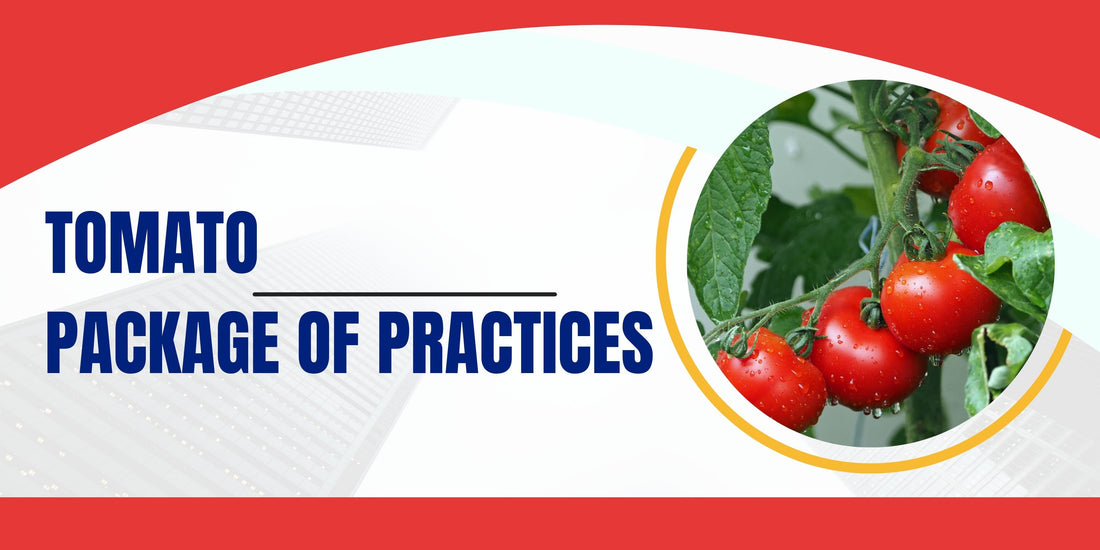
TOMATO PACKAGE OF PRACTICES
Introduction:
Tomato (Lycopersicon esculentum) is an annual or short lived perennial pubescent herb and greyish green curled uneven pinnate leaves. The flowers are off white bearing fruits which are red or yellow in colour. It is a self pollinated crop. Tomato is originated in Peru of South America. It is important commercial vegetable crop of India. It is the second most important crop of world after potato. Fruits are eaten raw or in cooked form. It is rich source of vitamin A, C, potassium and minerals. It is used in soup, juice and ketch up, powder.
Soil
It can be grown in varied type of soil ranging from sandy loam to clay, black soil and red soil having proper drainage. It gives best result when grown under well drained sandy soil with high organic content. For good growth pH of soil should be 7-8.5. It can tolerate moderate acidic and saline soil. Avoid cultivation in high acidic soils. For early crops, light soil is beneficial where for heavy yields clay loam and silt-loam soils are useful.
Land Preparation
For tomato plantation, it required well pulverise and levelled soil. To bring soil to fine tilth, plough land for 4-5times, then planking is done to make soil level. At time of last ploughing add well decomposed cow dung and Carbofuron@5kg or Neem cake@8kg per acre should be applied. Transplantation of tomato is done on raised bed. For that prepared raised bed of 80-90cm width. To destroy harmful soil borne pathogen, pest and organism, soil solarization is carried out. It can be done by using transparent plastic film as mulch. This sheet absorb radiation and thus increases soil temperature and kill pathogen.
Nursery Management And Transplanting
- Do solarization for one month before sowing. Sow tomato seeds on raised beds of 80-90cm width and of convenient length. After sowing covered bed with mulch and irrigate bed with Rose-Can daily in morning.
- To protect crop from virus attack cover nursery bed with fine nylon net.10-15days after transplanting sprayed 19:19:19 along with micronutrients@2.5 to 3gm/Ltr of water.
- Damping Off damages crop to great extent, to prevent crop from it avoid overcrowding of seedlings and keep soil wet. If wilting is observed, do drenching of Metalaxyl@2.5gm/Ltr water, 2-3 times till plants are ready for transplantation.
- Seedling is ready for transplantation 25 to 30days after sowing with 3-4leaves. In case if seedlings age is more than 30days transplant it after de-toping. Water seedling beds 24hours before transplanting so that seedlings can be easily uprooted and be turgid at transplanting time.
- To protect crop from bacterial wilt, dip seedlings in 100ppm Streptocycline solution for 5 minutes before transplanting.
Season of Planting :
Seeds are sown in June July for autumn winter crop and for spring summer crop seeds are sown in November. In the hills seed is sown in March April.
Spacing:
Spacing depends upon the type of variety grown and the season of planting. Normally the seedlings are transplanted at a spacing of 75-90 x 45-60 cm.
SowingDepth
In nursery sow seeds at depth of 4cm and then covered with soil.
Method of Planting
Seedlings are transplanted in furrows in light soils and on side of the ridges in case of heavy soils. A pre-soaking irrigation is given 3-4 days prior to transplanting. Before planting seedlings should be dipped in a solution prepared by Nuvacron (15ml) and Dithane M - 45 (25g) in 10 litres of water for 5-6 minutes. Transplanting should preferably be done in the evening.
SeedRate
Use seed rate of 100gm for preparing seedling for sowing in one acre land.
Seed treatment
- To avoid damping off disease treats the seed with Tricoderma @ 5-10 g/Kg seed or carbendazim 2g/Kg seed.
- The treated seeds are dried in shade for 30 minutes and then sown sparsely along the lines in ½ cm depth and then covered by the topsoil.
Weed Control
The field should be kept weed-free, especially in the initial stage of plant growth, as weeds compete with the crop and reduce the yield drastically. Frequent shallow cultivation should be done at regular interval so as to keep the field free from weeds and to facilitate soil aeration and proper root development. Deep cultivation is injurious because of the damage of roots and exposure of moist soil to the surface. Two-three hoeing and the earthing up are required to keep the crop free of weeds. Pre- emergence application of Basalin (1kg a.i./ha) or Pendimethalin (1kg a.i./ha), coupled with one hand weeding 45 days after transplanting is effective for control of weeds. Plastic mulching (black or transparent) can be used to control the weeds. Weeds can be controlled successfully by mulching plus use of herbicides such as Pendimethalin (0.75 kg a.i./ha) or Oxyfluorfen (0.12 kg a.i./ha).
Crop Rotation
Tomato should not be grown successively on the same field and a break of at least one year is required between planting of tomatoes or other Solanacesous crops (eg. Chillies, Brinjals, Capsicum, Potato, Tobacco, etc.), cucurbits and many other vegetables. The crops, which can be grown after tomatoes, are as follows- Cereals (eg. Rice, Corn Sorghum, Wheat, Millets, etc.) or Cruciferons crops (eg. Cabbage, Cauliflower, Kohlrabi etc) or Radish, Watermelon, Onion, Garlic, Groundnut, Cotton, Safflower , Sunflower, Sesame, Sugar beet and Marigold.
Intercropping
Tomato is well fitted in different cropping systems of cereals, grains, pulses and oilseeds. Cropping systems rice-tomato, rice-maize, okra-potato-tomato, tomato-onion are popular in various parts of India. Spinach or radish can also be grown as inter-crop in tomato successfully.
Staking
Due to the tall habit and heaving bearing nature of the hybrids staking is essential. Staking facilitates intercultural operations and helps in maintaining the quality of the fruits. It is done 2-3 weeks after transplanting. Staking can be done either by wooden stakes or laying overhead wires to which individual plant is tied. In case of indeterminate types, two or three wires are stretched parallel to each other along the row and plants are tied to these wires.
Irrigation
Tomato is very sensitive to water application. Heavy irrigation provided after a long spell of drought causes cracking of the fruits. Hence it should be avoided. Light irrigation should be given 3-4 days after transplanting. Irrigation intervals should be according to soil type and rainfall, irrigation should be given 7-8 days interval during kharif, during Rabi 10-12 days and 5- 6 days during summer. Flowering and fruit development are the critical stages of tomato therefore; water stress should not be given during this period.
Manuring & Fertilization
Manuring Varieties Basal dose : FYM 25 t/ha, NPK 75:100:50 kg / ha Borax 10 kg, Zinc sulphate 50 kg / ha
Top dressing : 75 kg N/ha on 30th day of planting or during earthing up.
Hybrids Basal dose : FYM 25 t/ha, NPK 50:250:100 kg/ha Borax 10 kg, Zinc sulphate 50 kg/ha, Copper sulphate 3.75kg/ha
Top dressing : N and K each 150 kg/ha in 3 equal splits at 30, 45 and 60 days after planting.
Foliar spray : 0.3% Boric acid at flowering and 10 days later
Growth Regulators
Effect of growth regulators in tomato crop is as follows
|
Plant-growth regulators |
Concentration (mg/litre) |
Method of application |
Attributes affected |
|
Gibberellic acid (GA) |
10-20 40-100 |
Foliar spray Seed treatment |
Higher yield at low temperature Seed germination |
|
Ethephon |
100-500 1,000 |
Foliar spray Pre-harvest spray |
Flowering, fruiting and yield Fruit ripening |
|
PCPA |
50-100 |
Foliar spray at low flowering |
Tomato fruit set at high temperatures |
Harvesting
Crop starts yielding by 70 days after planting. Usually fruits are harvested with hand by a gentle twist so that the stalk is retained on plant. Intervals of harvests depend on season and it is twice in a week during summer and weekly during winter and rainy days. Harvesting maturity depends on the purpose whether for fresh market, processing, long distance transport etc. Following maturity standards are recognized in tomato:
- Mature green:Fruits fully grown, fruit colour changes from green to yellowish and cavity filled with seeds surrounded by gelly like substance. Harvested for long distance market.
- Turning or breaker stage: Fruits firm, 1/4th portion of fruit changes to pink in colour, but the shoulder still yellowish green. Harvested for long distance market.
- Pink stage: 3/4th of whole fruit surface turns pink colour. Harvested for local market.
- Light red: Entire fruit surface is red or pink but the flesh is firm. Harvested for local market.
- Red ripe or hand ripe: Fully ripened and coloured. Flesh becomes soft. Harvested for processing and for seed extraction.
Yield
The yield per hectare varies greatly according to variety and season. On an average, the yield varies from 20-25 t/ha. Hybrid varieties may yield upto 50-60 t/ha.
IPM Package for Tomato
- Seed treatment with Pseudomonas fluorescens @ 10g/kg of seeds.
- Nursery application with Trichoderma viride and Pseudomonas fluorescens.
- Application of Neem cake @ 250kg/ha.
- Soil application of Pseudomonas fluorescens @ 2.5kg/ha.
- Selection of good and virus disease free seedlings for planting.
- Roguing out of virus infected plants upto 45 days of transplanting.
- Grow marigold as a border crop.
- Set up Helicoverpa / Spodoptera pheromone traps @ 12 numbers / ha.
- Release Trichogramma chilonis @ 50000/ha
- Install yellow sticky traps.
- Spraying Neem formulations (1%) / Neem seed kernel extract (5%).
